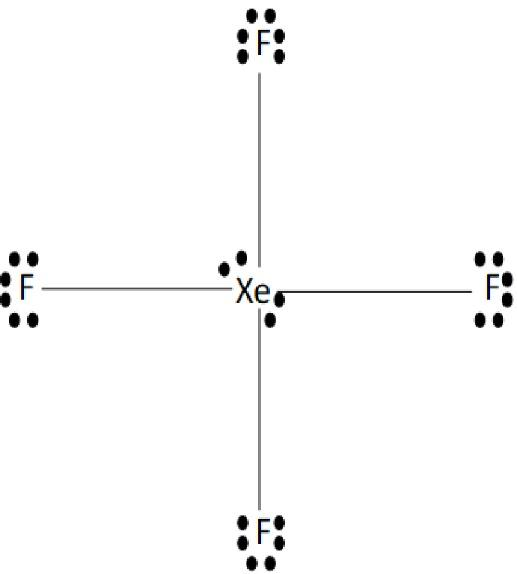
The compound of xenon with zero dipole moment is:
A. \[XeO{F_4}\]
B. \[Xe{O_2}\]
C. \[Xe{O_3}\]
D. \[Xe{F_4}\]
Answer
224.7k+ views
Hint: The zero dipole moment of a compound has symmetrical geometry and also has similar atoms with less distance between the charge separation.
Complete Step by Step Solution:
1. The dipole moment is the product of the magnitude of charge and the distance between the centre of the positive and negative charge.
2. It is expressed as:
\[\mu = Q \times r\]
Where, \[\mu \] =dipole moment
\[Q\] =charge
\[r\] =separation distance
3. The dipole moment is a vector quantity that is depicted on a Lewis structure as a crossed arrow.
4. A cross appears on the positive end while an arrowhead appears on the negative end.
5. The valence electrons of the xenon are eight and the valence electrons of the Fluoride are seven so the total valence electrons of the compound are thirty-six.
6. There are a total of two lone pairs on the xenon and it is attached to the four Fluoride atoms through the bond pairs.
7. The geometry of the xenon tetrafluoride is square planar with a symmetrical structure with an angle of \[{90^ \circ }\].
8. The zero dipole moment of the compound is defined as the two equal bond dipoles that point in the opposite directions and cancel the effect of each other.
9. The individual bond dipoles cancel out and leave the molecule as a nonpolar so there is no net dipole moment.
10. The Lewis dot structure of the xenon tetrafluoride is represented below:

Image: Xenon tetrafluoride
Option (D) is correct.
Additional information:
1. When the same forces of energy are applied at an angle of \[{90^ \circ }\], there is no movement.
2. The direction of the dipole moment is from a less electronegative atom to a more electronegative atom.
Note: The dipole moment arrow represents the direction of the shift of electron density in the molecule with the direction of the crossed arrow opposite the conventional direction of the dipole moment vector.
Complete Step by Step Solution:
1. The dipole moment is the product of the magnitude of charge and the distance between the centre of the positive and negative charge.
2. It is expressed as:
\[\mu = Q \times r\]
Where, \[\mu \] =dipole moment
\[Q\] =charge
\[r\] =separation distance
3. The dipole moment is a vector quantity that is depicted on a Lewis structure as a crossed arrow.
4. A cross appears on the positive end while an arrowhead appears on the negative end.
5. The valence electrons of the xenon are eight and the valence electrons of the Fluoride are seven so the total valence electrons of the compound are thirty-six.
6. There are a total of two lone pairs on the xenon and it is attached to the four Fluoride atoms through the bond pairs.
7. The geometry of the xenon tetrafluoride is square planar with a symmetrical structure with an angle of \[{90^ \circ }\].
8. The zero dipole moment of the compound is defined as the two equal bond dipoles that point in the opposite directions and cancel the effect of each other.
9. The individual bond dipoles cancel out and leave the molecule as a nonpolar so there is no net dipole moment.
10. The Lewis dot structure of the xenon tetrafluoride is represented below:

Image: Xenon tetrafluoride
Option (D) is correct.
Additional information:
1. When the same forces of energy are applied at an angle of \[{90^ \circ }\], there is no movement.
2. The direction of the dipole moment is from a less electronegative atom to a more electronegative atom.
Note: The dipole moment arrow represents the direction of the shift of electron density in the molecule with the direction of the crossed arrow opposite the conventional direction of the dipole moment vector.
Recently Updated Pages
JEE Mains 2026: Exam Dates and City Intimation slip OUT, Registration Open, Syllabus & Eligibility

JEE Main Candidate Login 2026 and Registration Portal | Form Access

JEE Main 2026 Session 1 Correction Window Started: Check Dates, Edit Link & Fees

JEE Isolation, Preparation and Properties of Non-metals Important Concepts and Tips for Exam Preparation

Isoelectronic Definition in Chemistry: Meaning, Examples & Trends

Ionisation Energy and Ionisation Potential Explained

Trending doubts
Understanding Electromagnetic Waves and Their Importance

Half Life of Zero Order Reaction for JEE

Understanding Collisions: Types and Examples for Students

Understanding Displacement and Velocity Time Graphs

Number of sigma and pi bonds in C2 molecule isare A class 11 chemistry JEE_Main

Understanding How a Current Loop Acts as a Magnetic Dipole

Other Pages
JEE Advanced 2026 - Exam Date (Released), Syllabus, Registration, Eligibility, Preparation, and More

JEE Advanced 2026 - Exam Date (Released), Syllabus, Registration, Eligibility, Preparation, and More

JEE Advanced 2026 Revision Notes for Practical Organic Chemistry

New Year's Day 2026: Significance, History, and How to Celebrate in India

Happy New Year 2026 Wishes – 100+ English, Hindi, Tamil, Bengali, Telugu Wishes, Quotes, Shayari, Status & Greetings

Revised CBSE Date Sheet 2026: Class 10, 12 Exam Schedule & Tips




